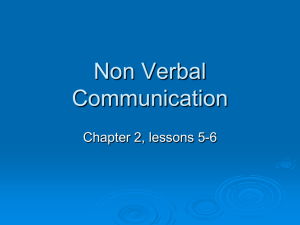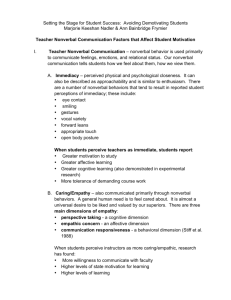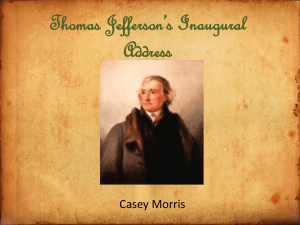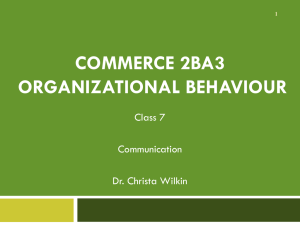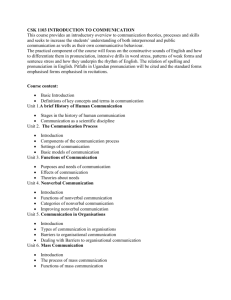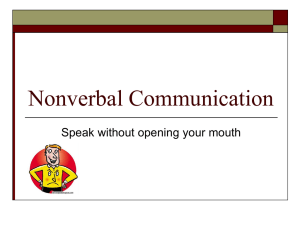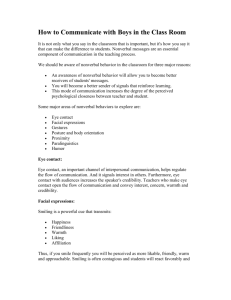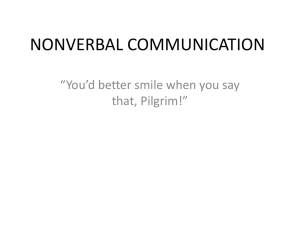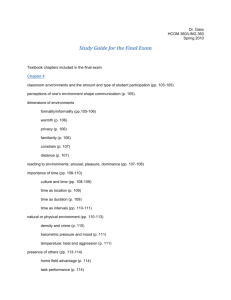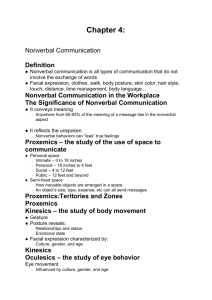Nonverbal Communication
advertisement
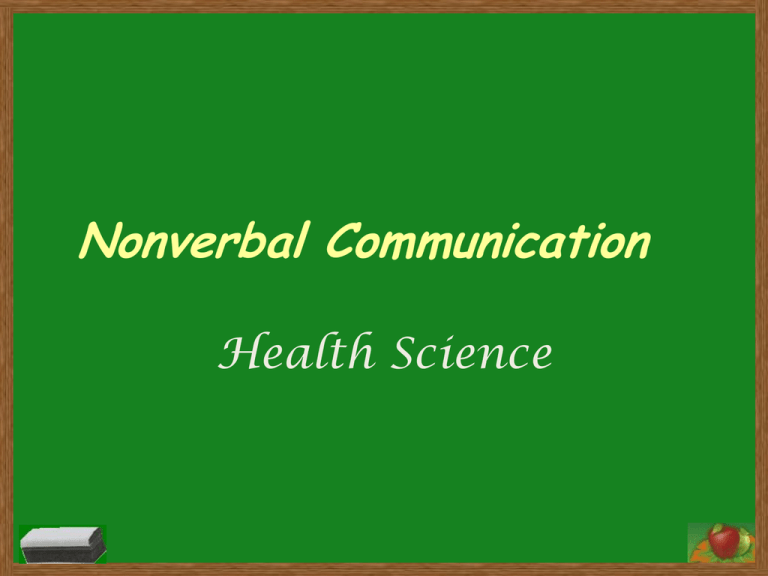
Nonverbal Communication Health Science • Research indicates that more time is spent communicating nonverbally than verbally, and nonverbal messages carry more meaning than verbal messages. • It is important to be aware of how nonverbal messages are perceived by others. 2 Objectives • Upon completion of this lesson, the student will be able to: • • examine nonverbal forms of communication, characteristics, and interpretation; • • improve nonverbal communication skills; • • adapt appropriate communications to the needs of the individual; • • explain the importance of nonverbal communication and • • act out a dialogue using gesture and expression only. 3 • Nonverbal communication: Sending and receiving wordless messages • A. Expresses more of the meaning of a message than verbal communication • B. Understanding the message • 1. 7% by spoken word • 2. 38% by the tone of the voice • 3. 55% by body language 4 Types of nonverbal communication • A. Gestures • 1. Express variety of feelings – a. contempt – b. hostility – c. approval – d. affection • 2. Can be used in addition to words • 3. Differ by culture 5 • B. Body Language and Posture • 1. unconscious barrier between you and the receiver – crossing arms • 2. sign of disbelief - scratching the chin • 3. good health and positive attitude – shown by erect posture • 4. fatigue -slumped posture • 5. angry - clenched fist • 6. anxiety - clearing the throat 6 • 7. assertiveness - pointing finger • 8. boredom - leaning on one's elbow with the chin in the hand • 9. boredom - wiggling a foot • 10. concealing something - no eye contact • 11. defiant - hands on hips • 12. dominance - sitting backwards on a chair • 13. doubtful - touching ear • 14. everything under control - thumbs in belt or pants 7 • 15. expectation - rubbing palms • 16. feeling superior - hands behind one's back • 17. guilt - lowering the eyes • 18. honesty - open palms occasionally touching the chest • 19. impatience - tapping or drumming fingers • 20. insecurity - biting fingernails • 21. interest in someone or something - tilted head 8 • 22. lack of confidence - failing to look someone in the eyes • 23. lying - touches face • 24. making a decision stroking chin • 25. needing reassurance hand to throat • 26. nervous - fiddling with items 9 • 27. readiness - standing with hands on hips • 28. rejecting what is being said - rubbing nose • 29. unconcerned - leg swung over chair • 30. unwilling - arms crossed tightly across chest 10 • • • • • • • • • • C. Facial Expressions 1. Most expressive part of the body 2. 7 universally accepted emotions a. fear b. anger c. surprise d. contempt e. disgust f. happiness g. sadness 11 • D. Eye Contact • 1. Often initiates communication • 2. Good contact means respect, a willingness to listen, and to keep communication open • 3. Looking away means anxiety, defenselessness, or avoidance of communication • 4. Cultural Differences • a. view eye contact as an invasion of privacy • b. eye contact considered disrespectful 12 • E. Object communication such as clothing and hairstyles • 1. Healthy people with good self-esteem pay attention to dress and grooming • 2. People feeling ill show much less interest in appearance and dress 13 • 3. Health Care Workers • a. Uniforms clean, neat and well fitting • b. If uniforms not required, clothing should be clean, neat and appropriate to the area, e.g. jeans may be allowed in recreation therapy but not in a nursing area or an office. 14 • F. Touch • 1. Multiple meanings / messages • a. positive: provides affirmation,reassurance, shares warmth, approval and emotional support. • b. negative: anger, frustration, punishment, • invasion of personal space • 2. Health care worker needs to weigh the benefits against the negatives when using touch. 15 Survey of Nonverbal Impressions Photographs 16
